URC Update | December 2023
2023 Puget Sound Peregrine Project: Annual Report
Although peregrine falcons are no longer endangered, we continue to monitor their nesting and breeding success in our region in the face of a growing human population. This year URC followed 11 nesting peregrine pairs: eight in Seattle and Tacoma, and three in the Cascade foothills. It’s fascinating to follow a single site regularly, often daily, throughout the breeding season, and even more so to be able to compare behaviors and outcomes across these urban and wild sites.
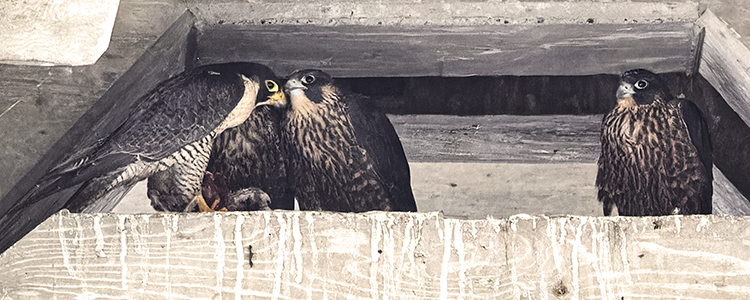
Feeding young at Portage Bay Bridge eyrie (Molly Cvetovac)
Seattle
Our knowledge of the Seattle sites benefited from a very well-supported effort, superb organization by URC’s new volunteer coordinator, Jenn Kovach, and, for the first time, two falcon cams: the long-time one downtown at 1201 3rd Ave and a new cam at AGC on South Lake Union. Volunteers documented incubation, predicted hatch dates, and showed up, often for hours, during the perilous fledging stage. Several sites are over water and, as in the previous few years, the URC peregrine navy once again had kayaks at the ready.
The East Channel Bridge nest failed. Although the adult pair went through the motions, no young were ever seen.
Four hatched and three fledged from the Portage Bay/520 Bridge. All of the fledglings died. The first fledged too early to fly well and glided to the roof of the adjacent marina. Urged by her screaming mother, the youngster tried to fly back up to the nest and hit the water instead. Jenn pursued her by kayak, but the bird outswam the kayak under the marina dock and into a maze of boat slips. Jenn’s shouting awakened a liveaboard, who rescued the fledgling. Off to PAWS to grow her wings.
The remaining two siblings fledged safely to the adjacent condo. One lounged on a balcony and nibbled on a light bulb; the second soon joined her. However, as evening approached, all was silent. Mom arrived with prey and wailed repeatedly, but the youngsters weren’t seen or heard again. The next morning, John and Jacki Gossman drove across the Portage Bay Bridge and found both fledglings dead on the highway, just above their eyrie. They had flown too low over the bridge, probably trying to return home, and they died together.
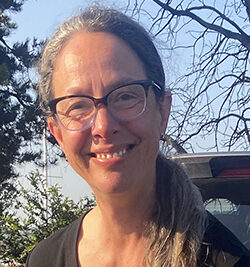
Jenn Kovach (Patti Loesche)
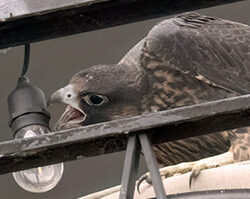
Portage Bay fledgling nibbling light bulb (Jeff Graham)
After two weeks at PAWS, fledgling #1 was released from the beach under the Portage Bay Bridge in view of her parents and flew straight to her eyrie. But after two weeks without young, the fledgling’s parents drove her from the territory. She returned a week later and tried again to go home, and again she was rejected. She was found the next day, emaciated and dead.
The honor-roll site of the season was at the AGC building on South Lake Union. The breeding pair, now in their second year, produced three eggs and hatched two. Both youngsters fledged successfully from their east-facing balcony over Lake Union, first around the corner to the south balcony, then off into the harrowing urban world of crows and windows. The fledglings took up their new residence at a South Lake Union condo, flying over the lake and returning to their natal site from time to time while they took hunting lessons from their parents. This was the only Seattle site in 2023 where young peregrines fledged without injury or mishap.
Banding
Thanks to the peregrine hosts at 1201 3rd and AGC, we banded the five nestlings at these two Seattle sites. The AGC adults were relatively gracious about the intrusion, but the 1201 female gave us a welcome that we won’t soon forget. Once the banded young were returned to the nest, everyone rapidly settled down.
The drama of the season played out at West Seattle Bridge. Last fall, one and probably both members of the long-resident adult pair died from avian flu (Highly Pathogenic Avian Influenza). A new pair arrived and chose a different nest site, inside a hollow concrete pier under the high bridge. We could only infer a hatch from prey deliveries to the hidden site. Finally two wobbly youngsters appeared. In early July, the first fledgling confidently launched from the site in pursuit of his prey-carrying father. His sister’s first flight the next morning didn’t go as well. Around 5:30 a.m., commuting cyclists were crossing the low (Spokane St.) bridge. One cyclist, Tracy Slatten, recognized a peregrine on the bridge—which began to swing open for ship traffic. When the bridge swung shut again, a scrum of waiting cyclists would surge across in both directions and imperil the bird. Realizing that, Tracy and two other cyclists scrambled for the peregrine and surrounded her with their bikes. She could not fly. These guys had to get to work. Now what? Just then Jenn showed up for her falcon vigil. She caught up the youngster and off it went to PAWS: short wings, broken sternum.
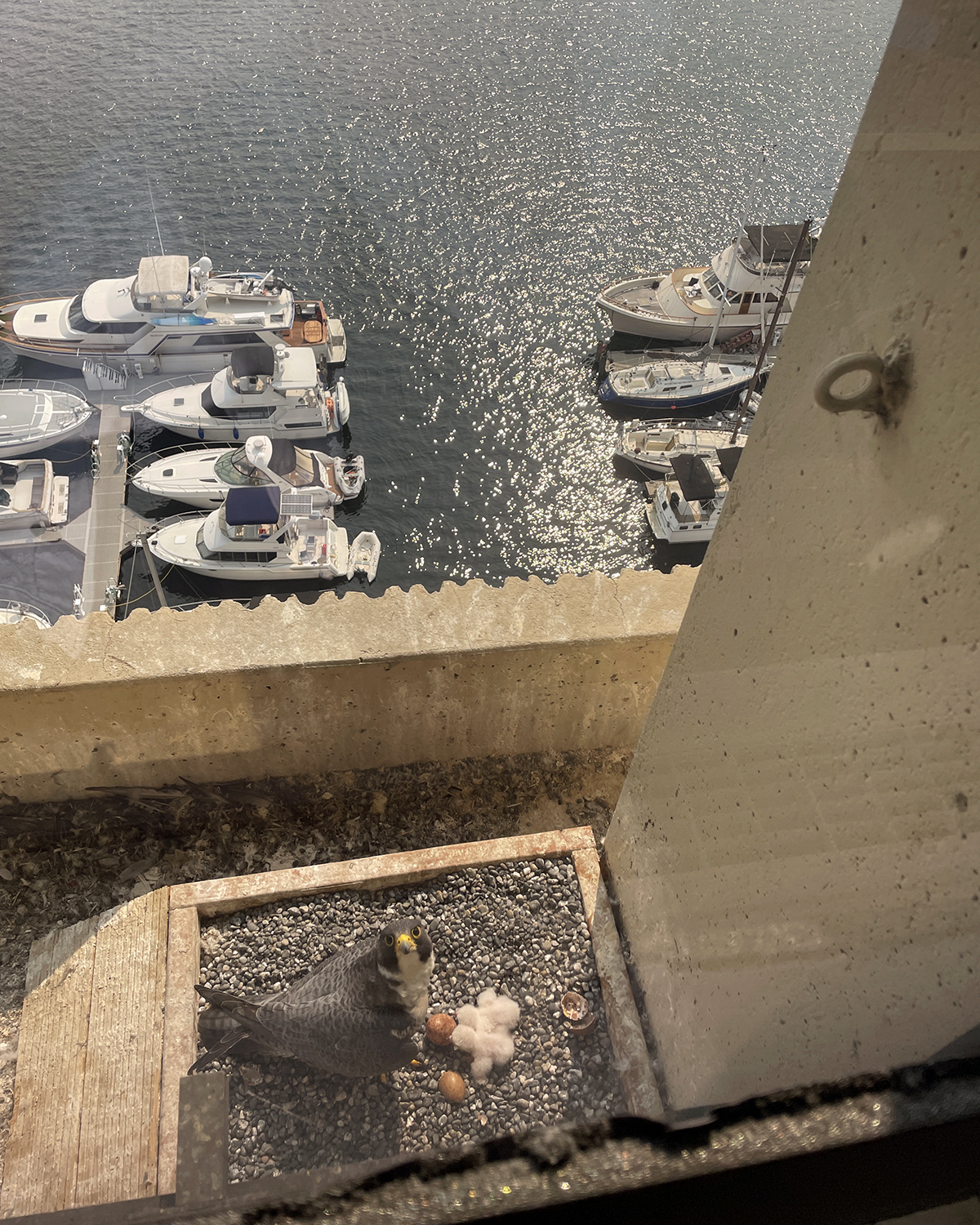
AGC female and two newly hatched young (Anne Hilton)
Twelve days later on a quiet Sunday morning, the young female, now banded 75-AK, was released on the same low bridge where she had crash-landed, with her father perched nearby. 75-AK flew well from the bridge to the old Tilbury cement silo and promptly began begging wails at her dad. When she next flew, dad was right behind her. Was he guarding or rejecting her? We found the youngster on a utility pole below the silo, still begging.
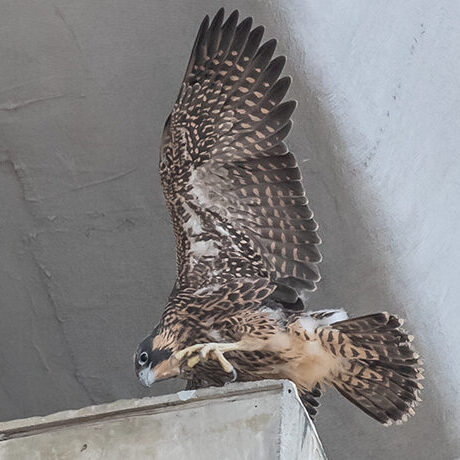
West Seattle male just before fledging (Jim Riley)
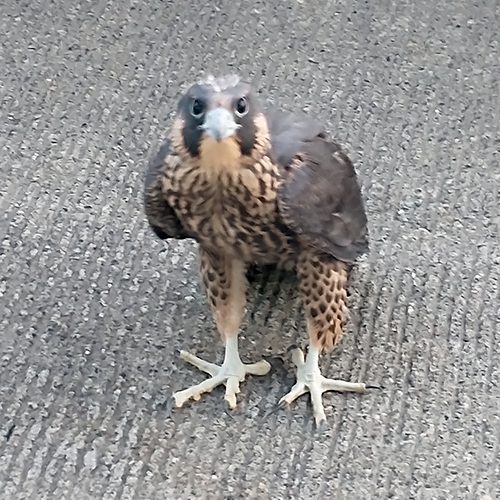
Newly fledged and injured West Seattle female (Sam Dwyer)
Mother and brother eventually appeared, so now the entire family was in evidence. 75-AK’s screaming escalated. Brother flew to an adjacent utility pole. Mom retrieved prey from a nearby stash and delivered it to… the male fledgling. 75-AK’s outrage knew no bounds. Then everything went right: 75-AK flew to her brother and his prey. He mantled it, but she quickly realized that she was bigger than he, and stole his prey—all benignly witnessed by both parents. This reunion couldn’t have gone better. 75-AK and her unbanded brother spent weeks learning to hunt pigeons at the old Fisher flour mill. They were last seen there by Tracy in late September before they dispersed.
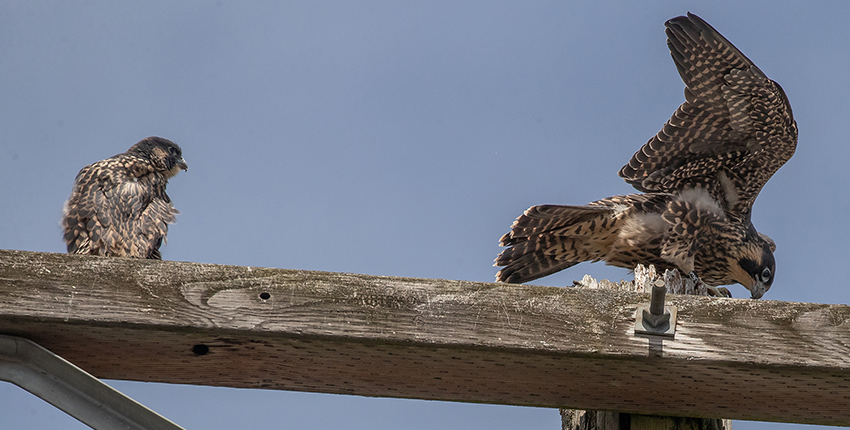
West Seattle fledglings reunited as rehabbed female 75-AK steals prey from her brother (Jim Riley)
Egg laying was late at the flagship site at 1201 3rd Ave. For weeks in April the resident adult female seemed to want no part of motherhood. She spent many long days at a condo in Belltown and seldom appeared at the 1201 nest site. In contrast, the male was often in the nest box, all but laying an egg himself. Finally, weeks later than usual, the first egg appeared, then two more. Three hatched, and all fledged in early July. The first glided 55 floors down to the street and crashed: another trip to PAWS, another broken sternum. The other two fledglings spent time on lower elevations of 1201 before embarking into the world. One was soon found at Pike Place Market, unable to fly and harassed by crows and a man trying to make it walk up his arm. As with the West Seattle fledgling, this bird was saved by the kindness of strangers. Celia, a young visitor to Seattle, watched the distressed bird for an hour and realized that the only help in sight was her. She got a fruit box from a market vendor, carried the bird back to her hotel in the box covered by a discarded hoody (not recommended under normal circumstances!), and wondered what to do next. The next day she found us, and this peregrine joined his brother at PAWS (broken clavicle). The brothers were released from the roof of 1201 and were met by their mother as they flew off over the city. They haven’t been seen since. Just when fledging season was almost over, the third 1201 fledgling was found in Japantown: window hit, PAWs, broken coracoid. He was released many days later.
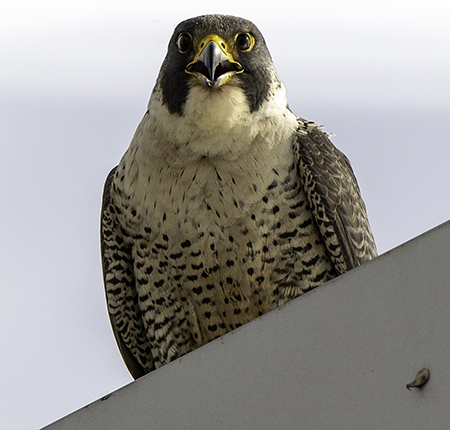
Unwelcoming committee: mom at 1201 3rd Ave on banding day (Matt Cryan)
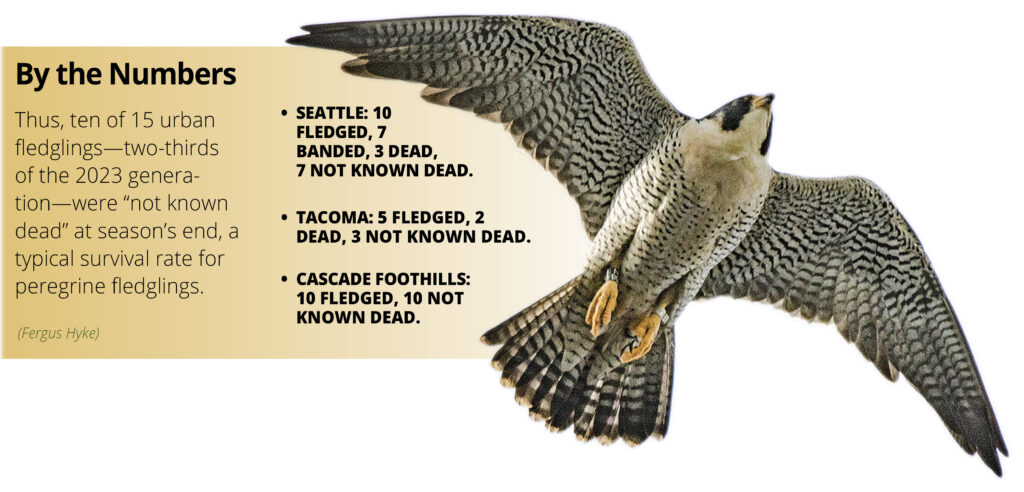
This past spring, Expedia Group on Elliott Bay asked URC to place a nest box on the roof of one of their campus buildings. Right next door is the Terminal 86 grain terminal, whose constant supply of pigeons has long been popular with peregrines. It will be interesting to see whether a breeding pair of peregrines will take advantage of this new piece of luxury real estate.
Tacoma
Roger Orness followed three eyries in Tacoma: Bradken, SR 509, and downtown Tacoma. Bradken fledged three. SR 509 failed during incubation. The long-time resident adult pair downtown, nicknamed Murray (banded N-08) and Harriet, were again courting downtown, although their nest box of many years had been removed in 2022. In May, Murray was in a territorial battle and hit the ground. This turned out to be his last fight. He was taken to PAWS where he died of his injuries. Murray was 19 years old, the fourth-oldest wild peregrine documented in North America. His eulogy was published in Tacoma’s Grit City Magazine (https://gritcitymag.com/2023/05/death-of-a-peregrine-a-tribute-to-the-king-of-tacomas-falcons/). How do peregrines grieve? By taking another mate. Harriet mated with the victor of that battle and the pair fledged two. Both youngsters died from window collisions.
Cascade Foothills
From April to August, Roger, often with Peter Anderson, also staked out three wild eyries east of Seattle, at Snoqualmie Falls, Olallie State Park, and Rattlesnake Ledge, usually twice a week. Unlike the urban peregrines, most of whom stumbled through various perils, some fatally, all of the fledglings from these sites fledged without apparent mishap. Snoqualmie Falls and Rattlesnake each fledged three and Olallie fledged four. Whatever these sites lacked in ease of visibility was more than compensated by seeing these young peregrines make it. Instead of growing up in a cramped eyrie, teetering on a low bridge, or launching into a window, these wild peregrines flutter-hopped among ledges until they were ready to fledge, and we watched them fly with increasing competence and skill until they began to disperse.
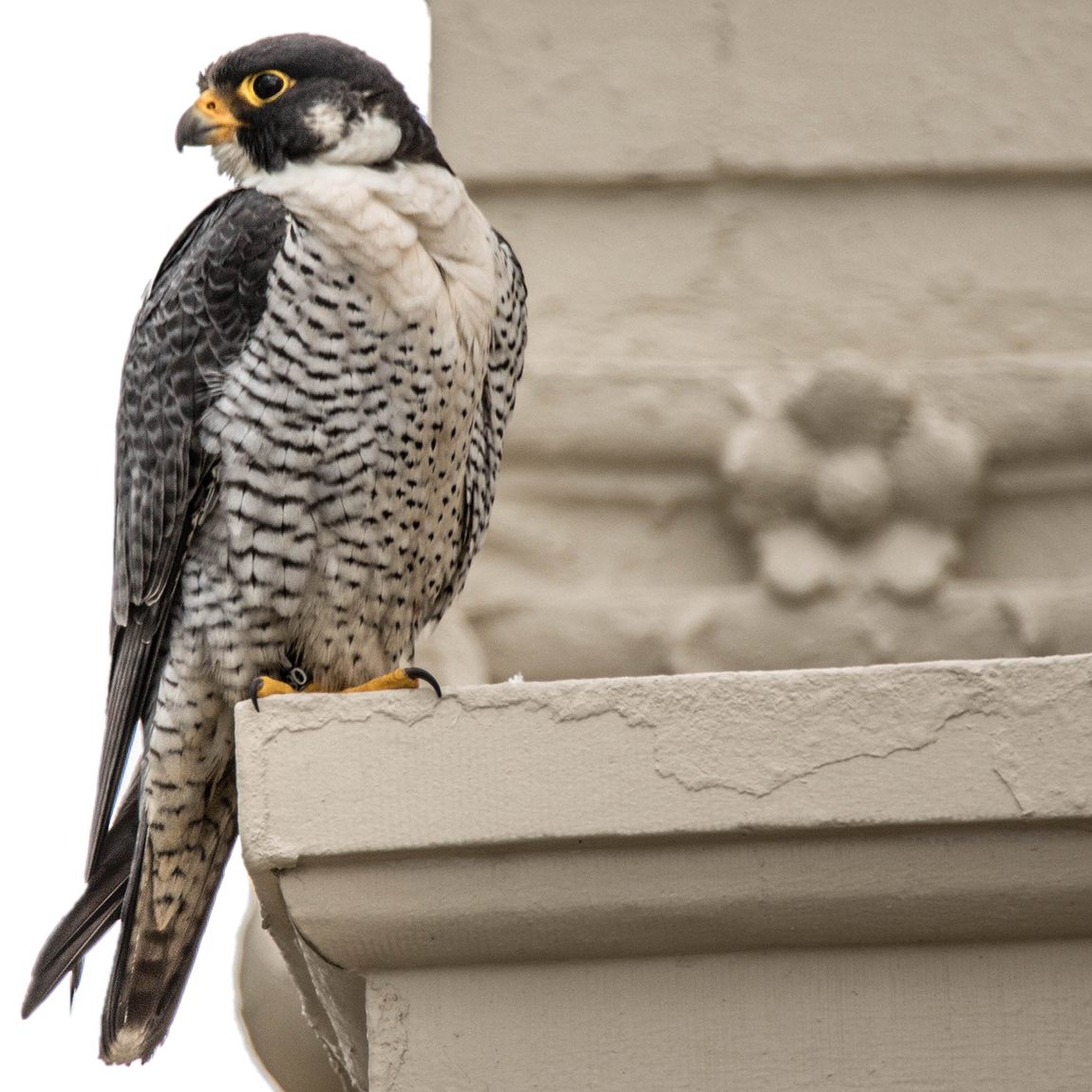
19-year-old peregrine “Murray” in Tacoma (Fergus Hyke)
Our heartfelt thanks to everyone who supported the 2023 peregrine season—not only the URC volunteers, who showed outstanding commitment throughout many weeks, but also people like Celia and Tracy, who rescued a peregrine fledgling without knowing what would happen next.